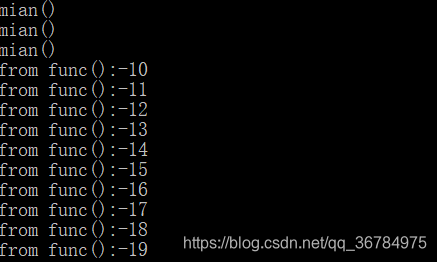#include <iostream>
#include <thread>
using namespace std;
void func()
{
for(int i = -10; i > -20; i--)
{
cout << "from func():" << i << endl;
}
}
int main() //主线程
{
cout << "mian()" << endl;
cout << "mian()" << endl;
cout << "mian()" << endl;
thread t(func); //子线程
t.join(); //等待子线程结束后才进入主线程
return 0;
}

#include <iostream>
#include <thread>
using namespace std;
void func()
{
for(int i = -10; i > -20; i--)
{
cout << "from func():" << i << endl;
}
}
int main() //主线程
{
thread t(func); //子线程
cout << "mian()" << endl;
cout << "mian()" << endl;
cout << "mian()" << endl;
t.join(); //等待子线程结束后才进入主线程
return 0;
}

#include <iostream>
#include <thread>
using namespace std;
void func()
{
for(int i = -10; i > -20; i--)
{
cout << "from func():" << i << endl;
}
}
int main() //主线程
{
thread t(func); //子线程
t.join(); //等待子线程结束后才进入主线程
cout << "mian()" << endl;
cout << "mian()" << endl;
cout << "mian()" << endl;
return 0;
}
- 1
- 2
- 3
- 4
- 5
- 6
- 7
- 8
- 9
- 10
- 11
- 12
- 13
- 14
- 15
- 16
- 17
- 18
- 19
- 20
- 21

detach()函数
称为分离线程函数,使用detach()函数会让线程在后台运行,即说明主线程不会等待子线程运行结束才结束
通常称分离线程为守护线程(daemon threads),UNIX中守护线程是指,没有任何显式的用户接口,并在后台运行的线程。这种线程的特点就是长时间运行;线程的生命周期可能会从某一个应用起始到结束,可能会在后台监视文件系统,还有可能对缓存进行清理,亦或对数据结构进行优化。另一方面,分离线程的另一方面只能确定线程什么时候结束,发后即忘(fire andforget)的任务就使用到线程的这种方式
#include <iostream>
#include <thread>
using namespace std;
void func()
{
for(int i = -10; i > -20; i--)
{
cout << "from func():" << i << endl;
}
}
int main() //主线程
{
cout << "mian()" << endl;
cout << "mian()" << endl;
cout << "mian()" << endl;
thread t(func); //子线程
t.detach(); //分离子线程
return 0;
}
- 1
- 2
- 3
- 4
- 5
- 6
- 7
- 8
- 9
- 10
- 11
- 12
- 13
- 14
- 15
- 16
- 17
- 18
- 19
- 20
- 21

可以明显看到,主线程太快了,还没等子线程运行就结束了
#include <iostream>
#include <thread>
using namespace std;
void func()
{
for(int i = -10; i > -20; i--)
{
cout << "from func():" << i << endl;
}
}
int main() //主线程
{
thread t(func); //子线程
cout << "mian()" << endl;
cout << "mian()" << endl;
cout << "mian()" << endl;
t.detach(); //分离子线程
return 0;
}
- 1
- 2
- 3
- 4
- 5
- 6
- 7
- 8
- 9
- 10
- 11
- 12
- 13
- 14
- 15
- 16
- 17
- 18
- 19
- 20
- 21

同样没等子线程运行完就结束了
#include <iostream>
#include <thread>
using namespace std;
void func()
{
for(int i = -10; i > -20; i--)
{
cout << "from func():" << i << endl;
}
}
int main() //主线程
{
thread t(func); //子线程
cout << "mian()" << endl;
cout << "mian()" << endl;
cout << "mian()" << endl;
t.detach(); //分离子线程
return 0;
}
- 1
- 2
- 3
- 4
- 5
- 6
- 7
- 8
- 9
- 10
- 11
- 12
- 13
- 14
- 15
- 16
- 17
- 18
- 19
- 20
- 21

没等子线程运行完就结束
总结
join()函数是一个等待线程函数,主线程需等待子线程运行结束后才可以结束(注意不是才可以运行,运行是并行的),如果打算等待对应线程,则需要细心挑选调用join()的位置
detach()函数是子线程的分离函数,当调用该函数后,线程就被分离到后台运行,主线程不需要等待该线程结束才结束






















 4139
4139











 被折叠的 条评论
为什么被折叠?
被折叠的 条评论
为什么被折叠?








